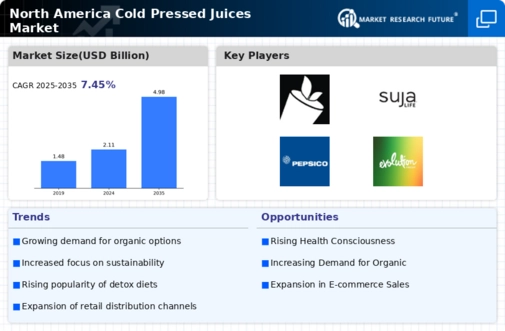Market Trends
Key Emerging Trends in the North America Cold Pressed Juices Market
The market dynamics of the North America cold-pressed juices industry are shaped by a variety of factors that influence supply, demand, and pricing trends within the market. Cold-pressed juices, made by pressing fruits and vegetables without heat or oxidation, have gained popularity in recent years due to their perceived health benefits and freshness. These juices preserve fruit freshness while offering a rich blend of essential vitamins, minerals, and vital nutrients crucial for maintaining optimal health and well-being.
Consumer demand is a significant driver of market dynamics within the North America cold-pressed juices industry. As consumers become more health-conscious and seek out natural and nutrient-rich beverages, the demand for cold-pressed juices has surged. Cold-pressed juices are perceived as healthier alternatives to traditional juices because they retain more nutrients and enzymes from the fruits and vegetables. Additionally, the trend towards plant-based diets and clean eating has further fueled demand for cold-pressed juices as convenient and nutritious options for consumers seeking to incorporate more fruits and vegetables into their diets.
Economic factors also play a crucial role in shaping market dynamics within the North America cold-pressed juices industry. Fluctuations in commodity prices, currency exchange rates, and input costs such as fruits, vegetables, and packaging materials can impact production costs and pricing strategies. Moreover, changes in disposable income levels and consumer spending habits can influence the affordability and accessibility of cold-pressed juices for consumers. Companies may adjust their product offerings and marketing strategies to cater to different consumer segments based on their price sensitivity and preferences.
Government regulations and policies impact market dynamics within the North America cold-pressed juices industry. Regulatory frameworks governing food safety, labeling requirements, and marketing claims influence the formulation, packaging, and sale of cold-pressed juices. Compliance with regulatory standards is essential for manufacturers to ensure product safety, legality, and consumer trust. Moreover, government initiatives to promote healthy eating and combat obesity may drive demand for cold-pressed juices as part of public health campaigns and nutrition education efforts.
Technological advancements and innovations drive product development and differentiation within the North America cold-pressed juices industry, influencing market dynamics. Advances in juicing technologies, such as high-pressure processing (HPP) and cold extraction methods, enable manufacturers to produce cold-pressed juices with extended shelf life, improved flavor profiles, and enhanced nutrient retention. Furthermore, innovations in flavor combinations, packaging formats, and marketing strategies enable companies to differentiate their cold-pressed juice products and capture market share. As a result, there has been a proliferation of innovative cold-pressed juice brands and product offerings in the North America market, ranging from single-ingredient juices to complex blends with added functional ingredients.
Environmental considerations are increasingly important in shaping market dynamics within the North America cold-pressed juices industry. Consumers are increasingly concerned about the environmental impact of food production and packaging, driving demand for sustainable and eco-friendly alternatives. Cold-pressed juices are often perceived as more environmentally friendly than traditional juices because they use less heat and produce less waste during processing. Moreover, companies may use recyclable or biodegradable packaging materials to minimize their environmental footprint and appeal to environmentally conscious consumers.







Leave a Comment